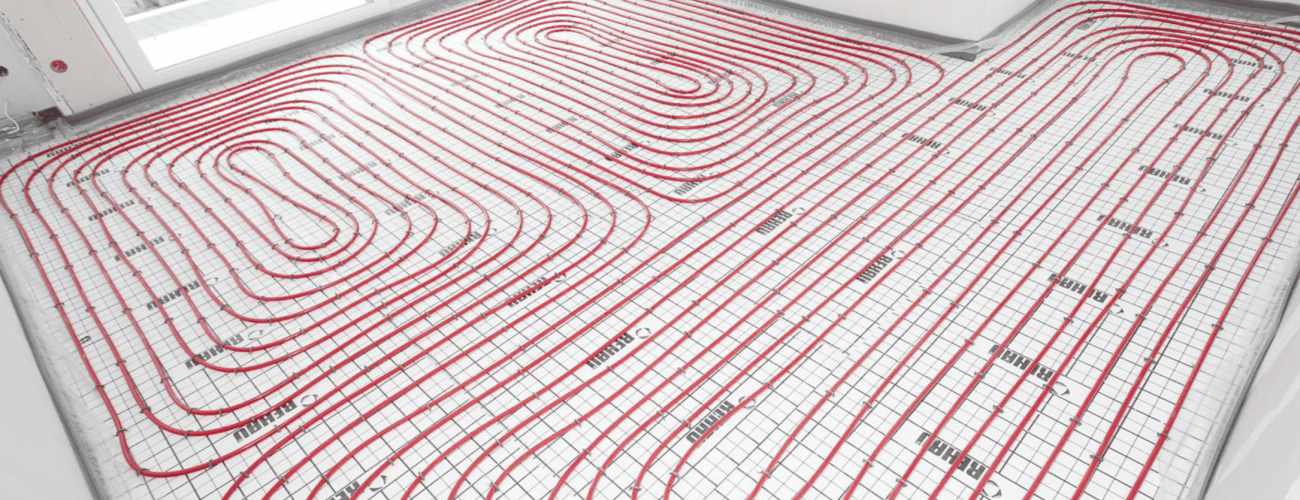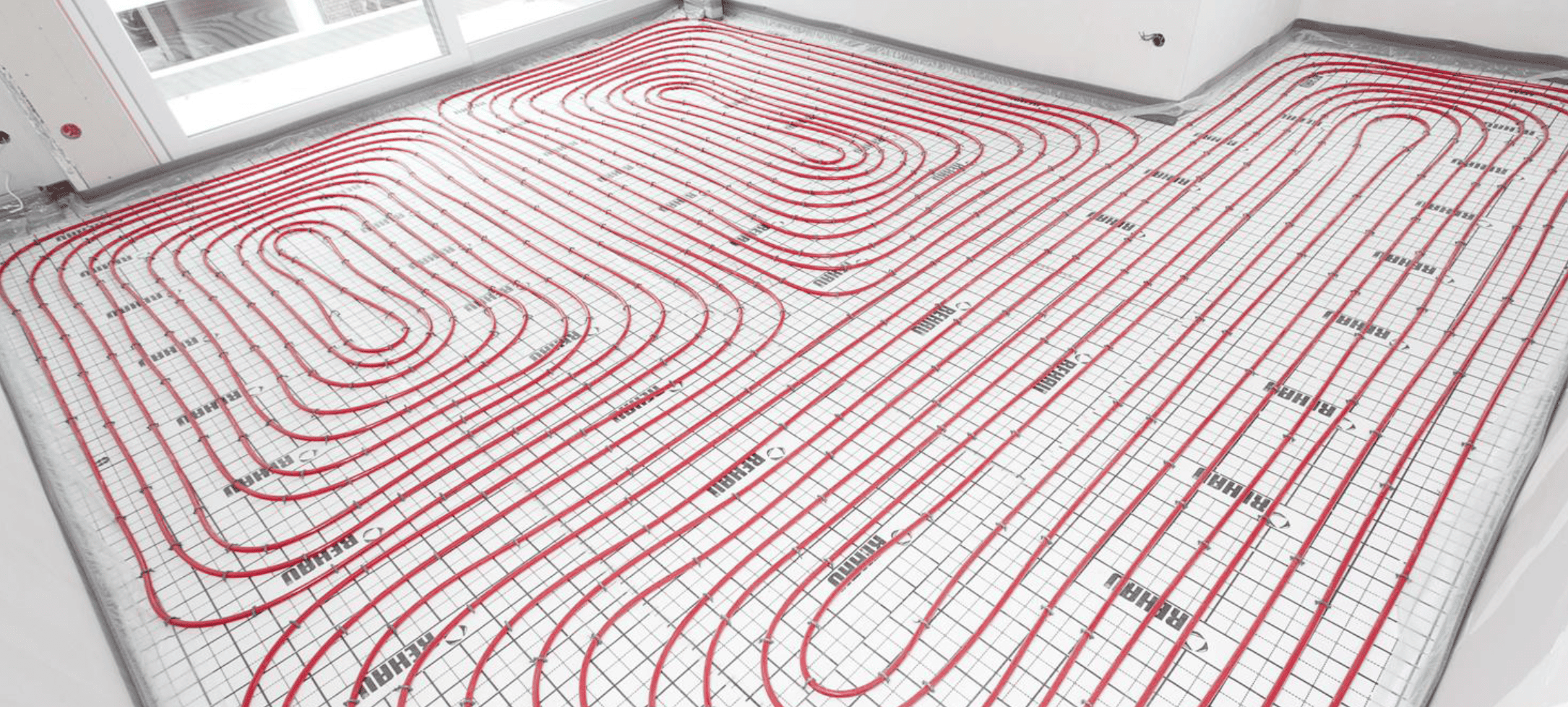Come along with us as we delve into the fantastic realm of underfloor heating. We will contrast underfloor heating with the conventional radiator, unveil the numerous advantages of this fashionable, sustainable alternative, and also address its limitations. If you’re contemplating the transition to underfloor heating, you’ve landed in the right spot.

What's on this page?
What is Underfloor Heating?
Underfloor heating is a method of heating that differs from traditional systems, which emit heat from a radiator. Instead, radiant floor heating is positioned beneath the floor to evenly warm the entire room.
There are two types of underfloor heating: water underfloor heating and electric underfloor heating. Water underfloor heating circulates heated water from the boiler through pipes to warm the room, while electric underfloor heating uses electricity through cables to achieve the same effect.
Although warm-water underfloor heating is approximately three times less expensive to operate than its electric counterparts, it entails a higher installation cost. More details about the two types of underfloor heating are provided in the table below.
| UFH SYSTEM TYPE | PROJECT SUITABILITY | RUNNING COSTS | INSTALLATION COSTS | INSTALLATION TIME |
|---|---|---|---|---|
| Warm water/wet underfloor heating | Suitable for all types of project including new build, renovation and single areas | Low long-term running costs | Higher upfront cost than electric UFH but much cheaper to run | Varies depending on project size and UFH system |
| Electric underfloor heating | Recommended for smaller spaces, like a bathroom, due to running cost. | Around 3x more than warm water underfloor heating | Generally cheaper to install | Install in a single room in just a few hours |
Underfloor Heating VS. Radiators
In the UK, central heating is the predominant method of keeping homes warm. It functions by circulating heated water from the boiler to the radiator, which then emits heat to heat up the room.
However, radiators have a drawback in that they often create temperature variations within a room. If you find yourself in a chilly area, you might need to increase the heating, use a plug-in electric heater, or add more layers of clothing. These options can lead to higher energy costs and inconvenience.
The remedy? Underfloor heating (UFH). With UFH, the entire room is heated evenly and efficiently, eliminating the issue of feeling cold because you’re not near the radiator.
Contrary to common belief, underfloor heating doesn’t only warm the floor. Since hot air rises, the underfloor system effectively heats the entire room.
Furthermore, UFH only needs to operate at temperatures between 25-30 degrees to be effective, whereas radiators typically require higher temperatures, usually between 60-80 degrees. Therefore, underfloor heating is not only better for the environment but also for reducing energy expenses.
Nevertheless, this doesn’t mean we have to completely eliminate radiators from our lives. Underfloor heaters and radiators can be used together in a complementary manner.
If you want to dive deeper into this topic, we have a whole article dedicated to underfloor heating vs. radiators.
What are the benefits of Underfloor Heating?
Here are the top 7 advantages of underfloor heating, including space-saving, cost-efficiency, and environmental benefits.
Space & style
Underfloor heating functions beneath the floor, remaining virtually unseen. Consequently, your interior design is not constrained by the location of radiators on the walls. This allows for greater creative freedom in decorating and arranging furniture. As a result, rooms will appear more expansive and exude a stylish, modern, and sophisticated ambiance.
Flexibility
Underfloor heating can be fitted in any type of property, whether upstairs or downstairs, in new constructions, extensions, or refurbishments. You have the flexibility to install it in a single room or throughout the entire house according to your preference. Underfloor heating accommodates your requirements, and it is adaptable to most floor types such as wood, carpet, tiles, laminate, and vinyl.
Energy efficient
Warm-water underfloor heating boasts 25% greater efficiency compared to radiators, and when combined with a heat pump, the efficiency reaches an impressive 40%. Underfloor heating covers a larger area than radiators at a lower temperature, yet it effectively heats the room, which is remarkably impressive. Additionally, this efficiency is advantageous for your energy bill, leading to a reduction in the energy needed to heat the room and consequently lowering your monthly expenses.
Sustainable
Transitioning to our next point, the enhanced energy efficiency of underfloor heating also contributes to its environmental friendliness. By installing an underfloor heating system, you can diminish your carbon emissions, subsequently reducing your carbon footprint.
Safe
Unlike radiators, underfloor heating lacks sharp edges or boiling points that could pose a safety risk, particularly for young children or the elderly. Moreover, floors with underfloor heating remain consistently comfortable to walk on, without becoming excessively hot. This feature ensures that cold floors feel warm and luxurious underfoot, even in the morning.
Low maintenance
Once your underfloor system is installed, managing it becomes effortless. You can conveniently regulate the temperature and set up a heating schedule using a smart thermostat, eliminating the need for manual adjustments each time. Additionally, our radiant floor systems offer lifetime tech support and warranty protection, providing you with added peace of mind.
Having delved into the advantages of underfloor heating, it’s equally important to evaluate its limitations.
Are there any drawbacks to Underfloor Heating?
Every product has its advantages and disadvantages, and underfloor heating is no exception. While we are inclined to think that the benefits outweigh the drawbacks, it’s important to address the potential downsides as well.
The majority of the drawbacks associated with underfloor heating are related to the installation process rather than its operation. Let’s delve into these drawbacks in more detail.
Purchase cost
The expense of underfloor heating is influenced by various factors, and it’s undeniable that it represents a significant investment. Nevertheless, underfloor heating can enhance the value of a property and lead to long-term savings on heating expenses.
For instance, the purchase of a custom screed underfloor heating system for a new construction with a 100m2 floor area would typically amount to around £5000 (£50 per square meter), excluding the cost of the screed, which might already be included in the new construction expenses.
In the case of renovations, the average cost for a downstairs floor area of 60m2 is roughly £6000 (£100 per square meter). The higher costs encompass all the necessary components for installing the underfloor system.
Installation cost
After acquiring the underfloor system, the next consideration is the installation cost. It’s crucial to ensure that the installation is carried out correctly by a certified heating and plumbing engineer. The cost can vary depending on the location within the UK and the type of underfloor heating system being implemented.
For instance, taking a 50m2 new build as an example, and assuming a professional charges £60 per hour, the installation cost is estimated to be around £1,715.
Alternatively, for smaller, more straightforward projects, there may be opportunities to reduce costs by personally handling the installation of the fixing system and tube, and then engaging a plumber to set up the manifold and connect it back to the boiler.
Electric running costs
It’s important to note that electric heating systems tend to have higher running costs compared to warm-water systems. Therefore, we advise limiting their use to smaller areas, such as bathrooms, rather than implementing them throughout the entire house.
Floor height
If you’re renovating, you can avoid the inconvenience of excavating your floor to install underfloor heating. However, it’s important to note that the floor height is likely to increase due to the installation of our overlay solutions on top of existing solid or timber floors.
Next steps
The upfront expense of underfloor heating and the installation process may deter some individuals, but the enduring advantages make it a worthwhile investment. Furthermore, pairing underfloor heating with a heat pump can significantly decrease carbon emissions and reduce reliance on the gas grid.
Get FREE Underfloor Heating
Find out how much an Underfloor Heating System would cost you
Complete A Short Form – Receive Free Quotes – Compare & Save
Get FREE Underfloor Heating Quotes
Find out how much an Underfloor Heating System would cost you
Complete A Short Form – Receive Free Quotes – Compare & Save






